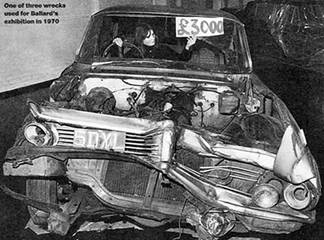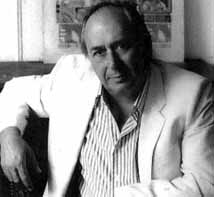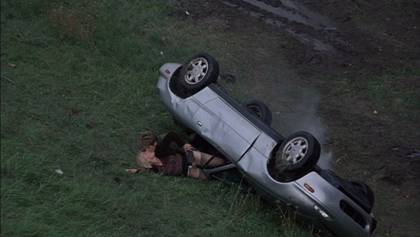ISSN: 1705-6411
Volume 6, Number 2 (July, 2009)
Author: Dr. Gerry Coulter
On Ballard: It is no longer to fabricate the unreal from the real, the imaginary from the givens of the real. The process will, rather, be the opposite: it will be to put decentred situations, models of simulation in place and to contrive to give them the feeling of the real… to reinvent the real as fiction (Baudrillard, 1994:124 and 2006:93).
Director: David Cronenberg, Crash [final scene]
(James Spader, Holly Hunter, 1996)
I believe in the power of the imagination to remake the world, to release the truth within us, to hold back the night, to transcend death, to charm motorways, to ingratiate ourselves with birds, to enlist the confidences of madmen. I believe in my own obsessions, in the beauty of the car crash, in the peace of the submerged forest, in the excitements of the deserted holiday beach, in the elegance of automobile graveyards, in the mystery of multi-storey car parks, in the poetry of abandoned hotels (J. G. Ballard, 1984, continued at end of this obituary).
J.G. Ballard’s novels and short stories read us. So too did the efforts to ban David Cronenberg’s film Crash – the first chapter of Britain’s nanny-culture fifteen years ago. This event was merely an echo an earlier attempt by the American publisher Doubleday to protect us from Ballard’s book The Atrocity Exhibition (in which a chapter called “Crash” appears). Facing an obscenity trial in the freest of all nations, the publisher destroyed the print run. In Crash the automobiles represent the mechanization of life in its most seductive form. The human characters display the raw fetish humans possess for our seductive technologies of death. This cerebral novel and movie is only disturbing for a person in very deep denial (the kind of denial a properly socialized person is given by our social system). If Crash really disturbs you, then you are far more distressing than it is. What mainstream action film doesn’t have at least half a dozen car crashes? “Telling”, Ballard must have thought as four lane highways were driven into the heart of all major cities and close by Ballard’s own house. To view Crash and most of Ballard’s writing as science fiction is to duck a series of troubling questions. Ballard himself was a good example of system failure – the failure of a system to integrate each individual into its pedestrian matrix of rationalities.
On the Ballardian website (Sellars, 2009) tells us that Ballard was a philosopher. Sellars has it right. The final scene from Ballard’s novel Crash, Cronenberg’s film adaptation is shown above [which Ballard said was “true to the book”], represents our entire culture, auto-culture, at the end of the 20th century. Ballard was, by times, a poet and like all good poets he could hear the laughter and music of flowers as he did in his first published short story (1956). His understanding of our culture and society, which served as the source of most of his work, was the underside of Pop.
Central to Ballard’s philosophy was a kind of surreal psychoanalysis of Western cultures. “At the age of sixteen I discovered Freud and the surrealists, a stick of bombs that fell in front of me, and destroyed all the bridges I was hesitating to cross” (see http://www.jgballard.ca/). Reading Ballard I am often reminded of the words Andre Masson published in La Révolution Surréaliste in October, 1925: “We … feel that life – whatever Western civilization has made of it – no longer has any right to exist, and that it is time to envelop ourselves in the night; within it we are able to find a new raison d’être” (see Richardson, 2007:322).
Baudrillard found England to be a very strange country but he liked J. G. Ballard (1993:208). On Ballard’s novel Crash, Baurdillard said: “it is the first great novel of the universe of simulation”, (Simulacra and Simulation, 1981:119) and “it is our world” (125). Baudrillard probably felt that Ballard understood, as he himself did, the automobile as the “centre of a new kind of subjectivity” (1996:67). It is also likely that Baudrillard developed his catchphrase title the Gulf War Did Not Take Place from Ballard’s War Fever. In Cool Memories III Baudrillard writes: “Ballard’s War Fever provides the counterpart to La Guerre du Golfe n’aura pas lieu. There, he has the Third World War taking place without anyone knowing it. Both are equally true” (1997: 75-76). Baudrillard said, later in the book, that Ballard’s Wind From Nowhere and Crash were the kind of science fiction he approved of: “paroxystic, extrapolating a detail, a characteristic feature and, by rigorous logic, revealing its eccentricity or extreme effects” (Ibid.:123). Baudrillard also enjoyed the Ballardian way of “projecting concepts into the void and killing them off in orbit. Their corpses continue to revolve around their Absent Referent like the bodies of the astronauts in their orbital sarcophagi in Ballard, rising and setting on the horizon like dead stars” (Baudrillard, 1996:71).
I will remember J. G. Ballard for his discerning eye, able as it was to penetrate past the gloss of our globalizing culture, to the vast wasteland which undergrids it… the ever expanding suburbs under the totalitarian eye of television. He went to the suburbs to live no doubt so that he could experience its devastating bleakness first hand – the mind-numbing consumerism (all roads lead to the shopping centres), surveillance (the oldest and still most powerful version of which are two eyes peering from behind a curtain), and long hours of unpaid work in front of the “tely” or in some prepackaged vacation. He probably chose to live in the controlled landscapes of conforming suburbia to find the best material. If you want to understand how the world gets uglier with the passage of time there is no place to do it like suburbia. Against it all he returned to the universe as much ambivalence and indifference as it heaped upon him. It became commonplace a few years back to trace the idea for the Matrix films to Baudrillard. To me I think the Wachowski’s brother’s placed Simulacra and Simulation in the first movie to throw us off of the more powerful source for their thinking – Ballard. Ballard did not write about a dystopian modernity as much as he understood that modernity is dystopian to its rotten and hypocritical core.
His work inspired art by others. In one case, without his direct involvement, a group of architects, designers, and actors put on a mixed media production of his 1966 short story, The Assassination Weapon. The story was performed as a multimedia adaptation under writer/director Stewart McKenzie. At the time a magazine described the scene:
In the centre of the room a large white disc slowly rotates. Projectors in the four corners flash images on to this double screen while a voice sonorously reads passages by J.G. Ballard … The superimposed photographs, surrealist paintings, charts and mandalas coupled with Ballard’s dense distressed sentences have the texture of an unhappy dream. A Max Ernst world-scape of mighty fragments… following the private logic of an hallucinating mind. Puzzling, frequently powerful, devised and invented with ingenuity and skill (Kingston, 1969:313-14).
In April 1970, in the New Arts Lab of the Institute of Contemporary Arts, Ballard himself put on the show “Crashed Cars”. The three cars used [a mini, an Austin (Cambridge A60) and a Pontiac] represented different class backgrounds as well as periods of production from the 50’s to 1970.

Exhibition display. Ballard “Crashed Cars” (1970) (http://www.ballardian.com)
The cars had been made equal by the event of the crash (broken, crushed, and stained). This work of art, like Ballard’s writing on this the theme of the crash, pointed to the deadly consequences of the machines we so willingly strap ourselves into (see Ford, 1970).
Ballard wrote against the banal molding of collective consciousness in a way that challenged the mental and visual horizons of readers. Perhaps he was inspired by the significant proportion of our society that continued to read (the present generation possibly marking a significant change). As for the mass, the ones who still read, their socialization probably protected most of them well enough from Ballard and they remained merely disturbed by him. For those whose level of resistance to social conditioning remained stronger, he encouraged the thinking of thoughts the system has no interest in our thinking. Bruce Sterling perceptively noted that Ballard was probably the most important harbinger of cyberpunk. His influence often broke through in the most surprising places as when a group of delightful rascals photocopied his “Why I want to Fuck Ronald Reagan” (from The Atrocity Exhibition) and distributed it at the 1980 Republican National Convention in America. This story was also a very good example of Ballard’s ability to imagine a psychology of the future. If he was attempting to write, as he once said, “a mythology of the future” it was deeply rooted in the now.
His memoirs were published in 2007 as Miracles of Life. In them he refers to the downing of the World Trade Centre’s Twin towers as “a brave attempt to free America from the 20th century”. This comment captures so much of Ballard’s ability to provoke by simply writing something he believed. He might have been the only person of our time who could breath the air in those landscapes Salvador Dali painted. Melting ice caps, time crystallized (as is historical time today by real time), a planet over-heating, ecological and urban disasters… it really doesn’t sound so futuristic anymore does it? Perhaps it is true to say of most of his characters that psychology is destiny. They aren’t the kind of people we root for as much as we are fascinated by them. But we know in our hearts that a character like Vaughan in Crash is no more insane than we are – and no less.
As one of our better cultural psychologists it appears that Ballard understood us quite well and where we are going. He studied us for over forty years, writing reports in the form of novels and short stories with faithful regularity. Like Harold Pinter he refused an Order of the British Empire which he saw as a charade helping to prop up the monarchy. David Pringle, writing about Ballard’s death for the Guardian made a very good point concerning his short stories saying: “Had he never written a novel [they] would still make Ballard a major writer”. His name became an adjective (Collins English Dictionary); he drank too much; his children liked him; and bands [including Radiohead], borrowed from his work. I have even heard the story, perhaps apocryphal, that Ballard’s inspiration led to the idea for The Buggle’s song “Video Killed The Radio-star” which was the first music video to air on MTV in 1981. A writer can never predict the shores upon which his influence will break.
Upon his death the mainstream obituaries have been fairly kind (journalists like to read more than they are usually allowed to let on), yet Ballard reads their authors to us when we see unthoughtful terms like his “wayward imagination”; “disturbing vision”; “mad view of existence”; “monstrous and terrifying”; “brutality and pessimism”, used to describe the man and his work. Of course it may all merely be journalistic nostalgia for that New York Times writer who said of Crash in a 1973 review: “hands-down, the most repulsive book I’ve yet come across”. “Mission accomplished” Ballard must have thought, delightedly.

James Graham Ballard
November 15, 1930 – April 19, 2009.
Ballard’s poem, “What I believe” (continued):
I believe in the forgotten runways of Wake Island, pointing towards the Pacifics of our imaginations. I believe in the mysterious beauty of Margaret Thatcher, in the arch of her nostrils and the sheen on her lower lip; in the melancholy of wounded Argentine conscripts; in the haunted smiles of filling station personnel; in my dream of Margaret Thatcher caressed by that young Argentine soldier in a forgotten motel watched by a tubercular filling station attendant. I believe in the beauty of all women, in the treachery of their imaginations, so close to my heart; in the junction of their disenchanted bodies with the enchanted chromium rails of supermarket counters; in their warm tolerance of my perversions. I believe in the death of tomorrow, in the exhaustion of time, in our search for a new time within the smiles of auto-route waitresses and the tired eyes of air-traffic controllers at out-of-season airports. I believe in the genital organs of great men and women, in the body postures of Ronald Reagan, Margaret Thatcher and Princess Di, in the sweet odours emanating from their lips as they regard the cameras of the entire world.
I believe in madness, in the truth of the inexplicable, in the common sense of stones, in the lunacy of flowers, in the disease stored up for the human race by the Apollo astronauts. I believe in nothing. I believe in Max Ernst, Delvaux, Dali, Titian, Goya, Leonardo, Vermeer, Chirico, Magritte, Redon, Durer, Tanguy, the Facteur Cheval, the Watts Towers, Boecklin, Francis Bacon, and all the invisible artists within the psychiatric institutions of the planet. I believe in the impossibility of existence, in the humour of mountains, in the absurdity of electromagnetism, in the farce of geometry, in the cruelty of arithmetic, in the murderous intent of logic.I believe in adolescent women, in their corruption by their own leg stances, in the purity of their disheveled bodies, in the traces of their pudenda left in the bathrooms of shabby motels. I believe in flight, in the beauty of the wing, and in the beauty of everything that has ever flown, in the stone thrown by a small child that carries with it the wisdom of statesmen and midwives. I believe in the gentleness of the surgeon’s knife, in the limitless geometry of the cinema screen, in the hidden universe within supermarkets, in the loneliness of the sun, in the garrulousness of planets, in the repetitiveness or ourselves, in the inexistence of the universe and the boredom of the atom. I believe in the light cast by video-recorders in department store windows, in the messianic insights of the radiator grilles of showroom automobiles, in the elegance of the oil stains on the engine nacelles of 747s parked on airport tarmacs. I believe in the non-existence of the past, in the death of the future, and the infinite possibilities of the present.
I believe in the derangement of the senses: in Rimbaud, William Burroughs, Huysmans, Genet, Celine, Swift, Defoe, Carroll, Coleridge, Kafka. I believe in the designers of the Pyramids, the Empire State Building, the Berlin Fuehrer bunker, the Wake Island runways. I believe in the body odours of Princess Di. I believe in the next five minutes. I believe in the history of my feet. I believe in migraines, the boredom of afternoons, the fear of calendars, the treachery of clocks. I believe in anxiety, psychosis and despair. I believe in the perversions, in the infatuations with trees, princesses, prime ministers, derelict filling stations (more beautiful than the Taj Mahal), clouds and birds. I believe in the death of the emotions and the triumph of the imagination. I believe in Tokyo, La Grande Motte, Wake Island, Eniwetok, Dealey Plaza. I believe in alcoholism, venereal disease, fever and exhaustion. I believe in pain. I believe in despair. I believe in all children. I believe in maps, diagrams, codes, chess-games, puzzles, airline timetables, airport indicator signs. I believe all excuses. I believe all reasons. I believe all hallucinations. I believe all anger. I believe all mythologies, memories, lies, fantasies, evasions. I believe in the mystery and melancholy of a hand, in the kindness of trees, in the wisdom of light (James G. Ballard, 1984).
About the Author
Dr. Gerry Coulter is from Bishop’s University, Sherbrooke, Quebec, Canada
References
J. G. Ballard (1956) “Prima Belladonna” Science Fantasy Magazine.
J. G. Ballard (1984). “What I Believe” in Mediapart Journal. http://www.mediapart.fr/club/blog/samuel-dixneuf/200409/what-i-believe-jg-ballard; also available online at Traumaunit: http://traumaunit.blogspot.com/2008/08/what-i-believe-jg-ballard.html
Jean Baudrillard ([c1968], 1996). The System of Objects. New York, Verso, 1996. Translated by James Benedict.
Jean Baudrillard (c1981], 1994). Simulacra and Simulation. Ann Arbor: University of Michigan Press.
Jean Baudrillard (1993). Baudrillard Live: Selected Interviews. London: Routledge. (Edited by Mike Gane).
Jean Baudrillard ([c1995], 1997). Fragments: Cool Memories III. New York: Verso.
Jean Baudrillard (2006). Cool Memories V. London: Polity.
Simon Ford (1970). “A Psychopathic Hymn: J.G. Ballard’s ‘Crashed Cars’ Exhibition of 1970”: http://www.slashseconds.org/issues/001/001/articles/13_sford/index.php
Jeremy Kingston (1969). “At The Theatre”, Punch, (August 20):313-314 [cited in Simon Ford (1970)].
John Richardson (2007). A Life of Picasso: The Triumphant Years (1917-32). New York: Knopf.
Simon Sellars (2009). R.I.P. J. G. Ballard. http://www.ballardian.com/rip-jg-ballard-1930-2009
